Looking for something specific?


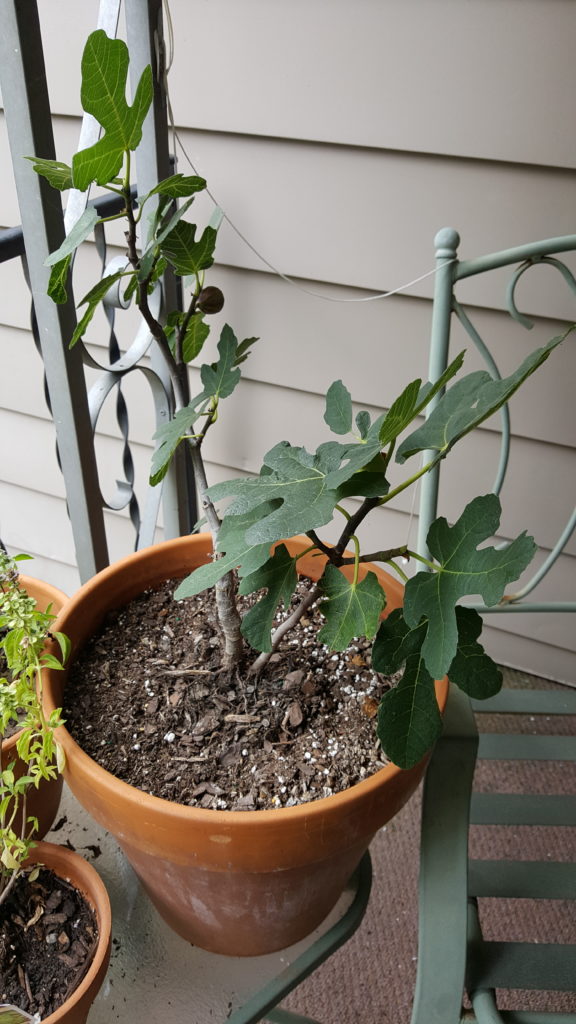
My first fig tree, 2016
Ever since 2016 when I saw a fig tree for sale at Lowes and convinced my mother to buy it, I have wanted to grow figs. Fresh figs are exotic to me. We always had dried figs when I was growing up. But the first time I had a FRESH fig was when I was in highschool, and I was immediately fascinated. Fresh figs are flavorful and juicy and nothing like their dried - and often hard - counterparts. The trouble is, they also like warm weather. Or at least, warmer winters than we get in west-central Illinois, USDA zone 5. That makes fig tree care a challenge.
Fortunately, there are cold hardy figs.
The Chicago Hardy Fig is usually listed as being hardy from zone 5 to 10. So as the name suggests, that means you should be able to grow it even as far north as Chicago.
But there is a caveat to the "hardiness" of Chicago Hardy Figs: the plant [i]should[/i] survive the whole winter, but it will usually die back. Generally when a plant is labeled "hardy in zone 5" that means it will fully survive the winter. In the case of Chicago Hardy Figs, their branches are only hardy down to 10 degrees Fahrenheit. This means that the tree will die back to its roots every year - even in a "mild" Illinois winter - and have to re-grow. It is only the roots which are hardy down to -20 degrees Fahrenheit (i.e. zone 5 winters).[source]
The good news is that the tree should produce figs on the new growth. But regrowing every year is, of course, a setback. You may only get one crop of figs, instead of the usual two per year.
The bottom line is that to grow a healthy fig tree in zone five, you need to protect it during the winter.
There are a few different options to protect your tree during the winter. One of them is to grow the fig tree in a pot, and then bring it inside. Another is to plant it in the ground, and wrap it up with burlap or another insulating material. And a third is to "heel in" your tree.
My first attempt to grow figs was in a pot, with the idea that I would bring the tree inside in the winter. This can be a very easy way to keep your fig safe over-winter, and care for your fig tree all year long. I have seen this method well for multiple years on end.
But there is a problem that comes with any potted plant that is kept outside in the summer, and brought in for the winter: bugs. The first year I brought my fig tree inside, it seemed to do really well. It survived the winter, and put on figs. But then the fruit began shriveling, and the tree started loosing its leaves. The cause? Mealybugs. I saved the tree (and you can read about it here), but pest problems remained a constant struggle.
The trouble is that pests, when they are outside, are naturally kept in check. But inside there is no cold weather or predators to keep them in check, and they can take over. So, if you are going to bring your fig tree inside, don't forget to treat it for bugs!
Fig trees are still trees, and as such, they will be happiest in the ground where their roots can stretch out. But remember, the hardiest of fig tree branches can still only take down to 10 degrees Fahrenheit. Even a mild zone five winter will have a cold night or two at or below that temperature. A cold winter will have multiple days below 0 degrees Fahrenheit.
So if you are going to try to keep your tree out all winter, they need a LOT of insulation. A sheltered southern-facing location would help. They will also need to be wrapped up in something insulating - such as burlap or bubble wrap, or both. Simply mounding leaves or mulch over their base will not be enough.
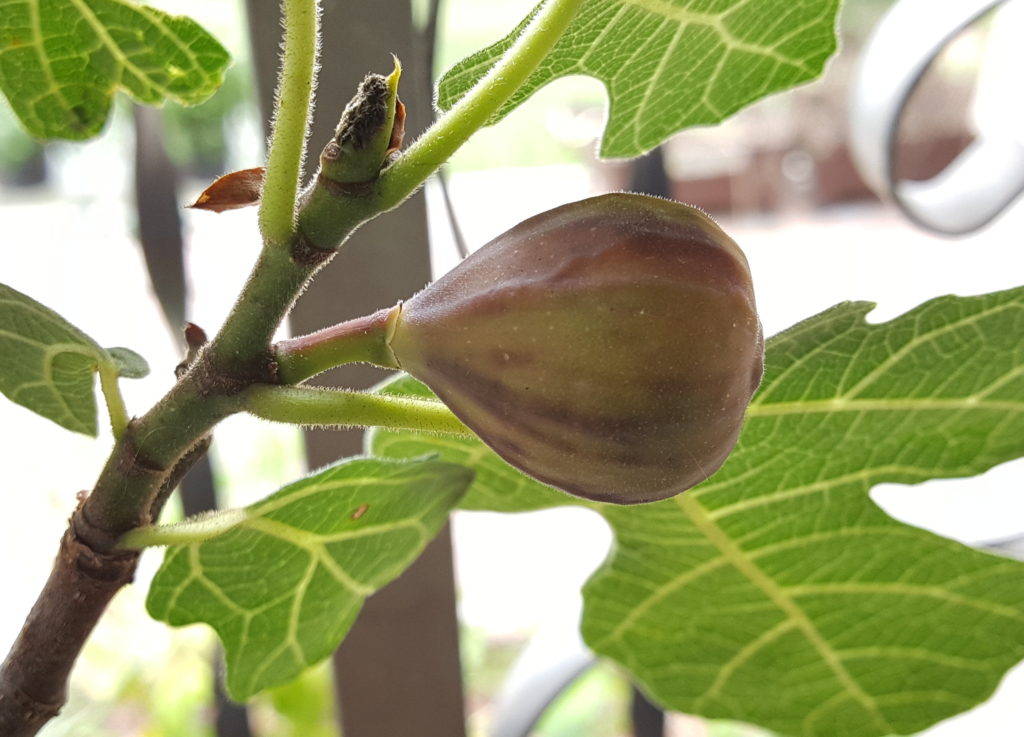
A delicious fig - the reward for good fig tree care
In the same vein as wrapping your tree, but even more protective, is "heeling in" the tree. Essentially, you dig a trench, and very carefully bend the tree over so that it is "laying down" in the trench. Then you cover it with mulch, sawdust, or the like.[source]
I have never been brave enough to try this method, but you can read about one person's experience with it here.
Winter care aside, figs are temperamental trees. Any discomfort is met with a giant temper tantrum.
And what does a tree temper tantrum look like? Why, dropping all its leaves, of course.
Is it too hot? The fig tree looses its leaves. Too cold? Drop those leaves. Too wet? Too dry? You guessed it... the leaves are falling.
But most of the time, when the fig's feelings are hurt, its a matter of water. Figs need a TON of water, which is a good argument for keeping them in the ground as opposed to a pot. If you do keep your fig in a pot, keep in mind that it will need to be watered every day in the summer. It may even need as much as a gallon or two of water a day once it gets big.
My first fig tree died a few years ago - I had to leave it overlong one winter, and that was too much stress for it. But that does not mean I have given up on figs! I have a new fig tree, in a large pot on my back patio. Come winter, I plan to wrap it up and put it in the garage for protection. I will update this post in the spring with my experience.
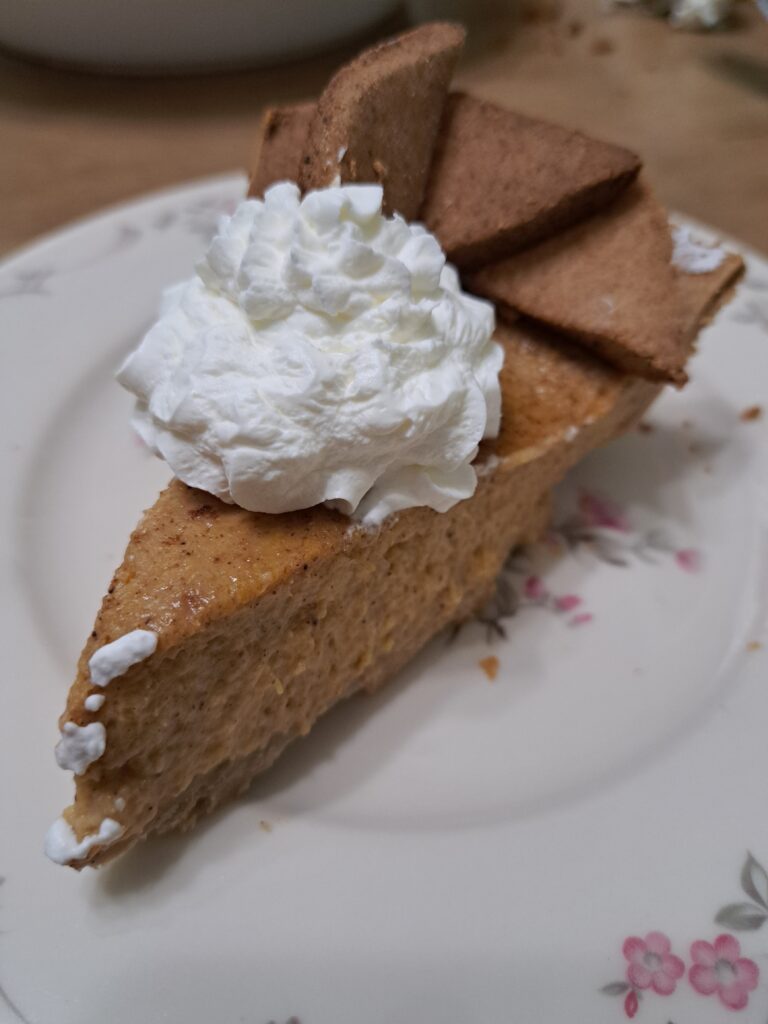
Think pumpkin, warm spices, custard, and a dollop of whipped cream - isn't that the taste of fall? This gluten free pumpkin pie recipe will let you conjure that fall feel any time of year!
I recommend using my pie crust recipe with this pie, but with a little bit of sugar and spices added. Putting some of the sugar in the crust makes it so much more flavorful, and compliments the filling better. I find that a less sweet filling with a slightly sweet crust makes for the perfect pumpkin pie.
It is so easy to just buy a can of pumpkin from the store. Its cheap. Its smooth and well puree'd. The perfect base for pie... in theory.
It also tastes a little bit like the can it came in, doesn't it?
The thing is, it is not actually that difficult to prepare and keep fresh pumpkin puree on hand. It just takes a little bit of planning.
Every fall, I buy a bunch of pie pumpkins. I cut off the tops, and scoop out the middle. Then I chop them in half, and bake them in the oven at ~250 degrees Fahrenheit for a few hours - until the flesh is soft. I take them out, let them cool, and then slip the skins off. Mash the soft pumpkin together, and the result is pumpkin puree, ready to be baked into a pie, or bread, or scones... whatever your favorite fall treat is!
I usually freeze the pumpkin in quart containers or bags, to be used throughout the year.
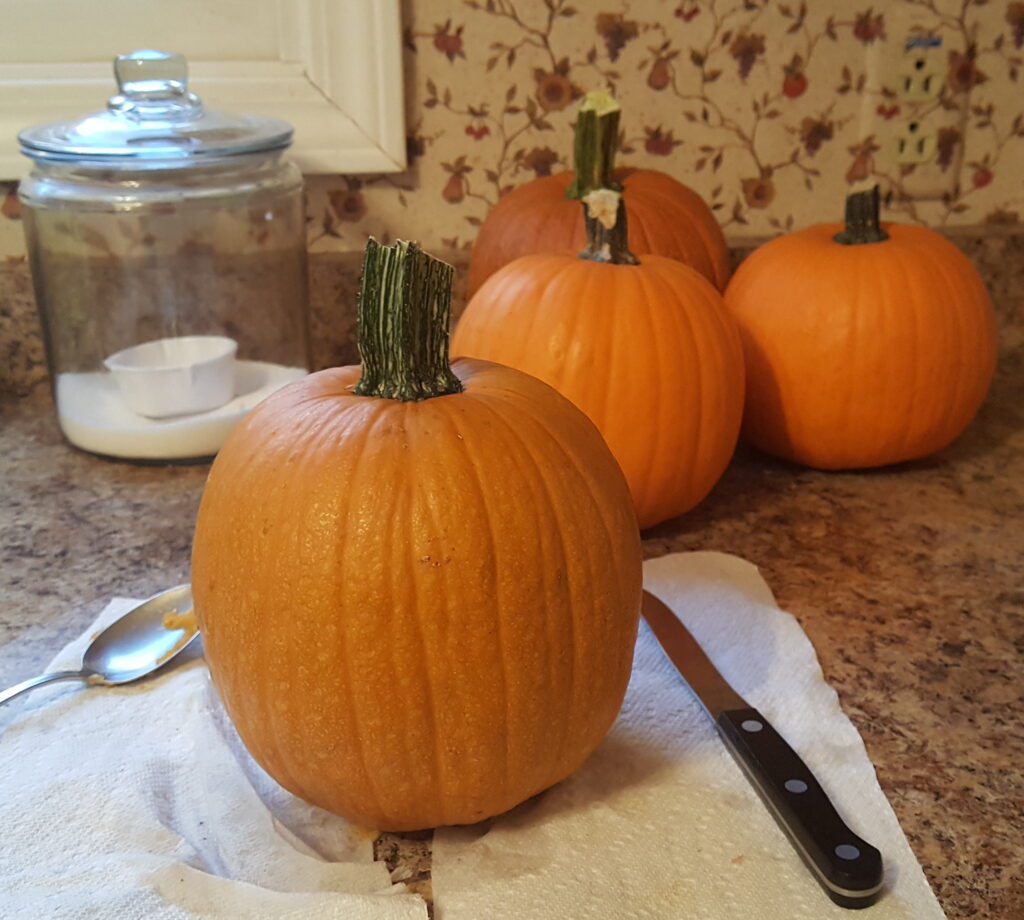
Homegrown pumpkin, ready to be processed
In case it was not enough that pumpkin pie is delicious, and a Thanksgiving staple, it is also the state pie of Illinois! Yes, Illinois has had a state pie since 2015, and that pie is pumpkin. Why? Because Illinois produces 85% of the pumpkin consumed in the United States.[source] So if you are from Illinois, it isn't just a pleasure to enjoy a slice of pumpkin pie from time to time. Its a duty.
Pumpkin is a New World food, and pumpkin pie is an invention of New England. The fact that pumpkin isn't a historical part of the European diet is hinted at in the name. Pumpkin comes from the older word pumpion, which traces its routes back to ancient Greek, and just meant "melon."[source] I don't really think of a melon when I think of pumpkin, but they are both gourds, so I suppose it made sense at the time.
Pumpkins were a staple of the New England diet in the 1600's. They were easy to grow - being native - and used in a wide variety of dishes, including pie. There was an older version of the pumpkin pie, made with pumpkin slices instead of stewed, roasted, or puree'd pumpkin. But by the end of the 1700's, the pumpkin pie had become the custard pie we know it today, made with stewed pumpkin, eggs, sugar, cream, and spices.[source]
Of course, the historical pumpkin pie was not gluten free. But this one is!

A delicious bite of sugar cream pie, flavored with allspice and cinnamon
An old-fashioned midwestern pie, sugar cream pie is a delicious old-fashioned custard pie. The top gets a beautiful golden brown color as the sugar caramelizes, and the interior is nothing but creamy goodness. You can add a dash of cinnamon, or other spices, or enjoy it as the anything-but-plain sugar cream pie that it is.
I suggest using my gluten free pie crust recipe for this pie, and making it in a deep dish pie dish. My pie crust recipe will provide a delicious buttery base, and deep dish pies are just the best. After all, deep dish means more filling, and filling is the best part!
Speaking of filling, this recipe does make a generous amount, so you really will want to consider that deep dish pie plate.
Sugar cream pie is the unofficial pie of the state of Indiana. I say "unofficial" because the attempt to make it the official state pie of Indiana fizzled in 2009, though visitindiana.com does list it as the official unofficial state pie. I'm not sure what was controversial about the pie that they did not officially crown it. Or was it that they simply thought there were more important things to codify than pie? I was unable to find out why it remains unofficial, just that the bill failed to make it to the desk of the Governor of Indiana.[source]
Sugar cream pie dates back to sometime in the 1800's. It is usually credited to the Shaker or Amish communities, and the oldest known recipe purports to be from 1816.[source] The pie is made with ingredients that people in the 19th century were likely to have in their pantries: milk or cream, sugar, and maybe eggs (the eggs are controversial). Because it only requires basic ingredients - no fresh fruit, or anything expensive - it is classified as a "desperation pie." Its the pie you can make all year long, even if times are tough.

See those little bubbles? This is what your pie should look like when its done.
That said, in the modern day, I'm not sure that butter and cream are so much cheaper than fruit, so your mileage may vary on the "desperation" angle. And it should also go without saying that nobody was making this pie gluten free "back in the day." But no one should have to go without trying a slice of this creamy goodness.
And certainly, you are not going to feel deprived while eating this rich and delicious pie!
This recipe is not very fussy. Mix the custard ingredients together, pour them into the crust, and put in the oven to bake. The pie will gradually start bubbling at the edges, and then the bubbles will move towards the middle until the whole top is bubbling. You need to be patient and wait for the whole pie to bubble, all the way across the top. This takes at least an hour. Impatience leads to a soupy pie.
While you can enjoy the pie straight out of the oven, it is best enjoyed after being chilled in the refrigerator for a few hours. This will help it firm up some more.
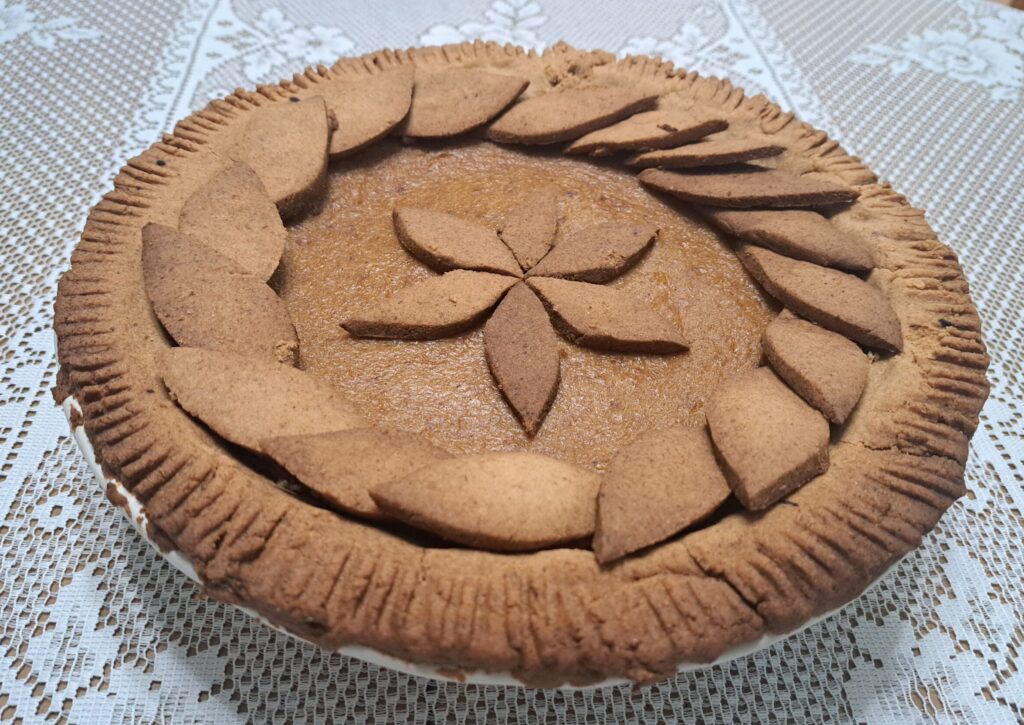
A pumpkin pie - look at those little leaves! All gluten free!
A buttery gluten free pie crust recipe, which you can use for any sort of pie you require. Sweet pie? Add a little sugar to the dough. Savory? Make the recipe as is.
This pie crust is workable enough for all your gluten free pie needs. It does one crust, two crust, and lattice topped pies. The dough is delicate - there is no working around that with a gluten free recipe. But you can roll it out and form it into shapes if you want a "fancy" looking pie.
This recipe is entirely butter based - no shortening, or other fat. This gives it a wonderful richness. Because we don't want to harm the integrity of the dough while cooking, this recipe does not call for the butter to be "cut" into the dough. You can melt or soften the butter, and then directly add it to the flour.
This means that the finished crust will not be flakey. But the dough will be workable, and it will have a wonderful light and crumbly texture. This works beautifully for fruit pies, custard pies, or whatever other pie type you might desire.
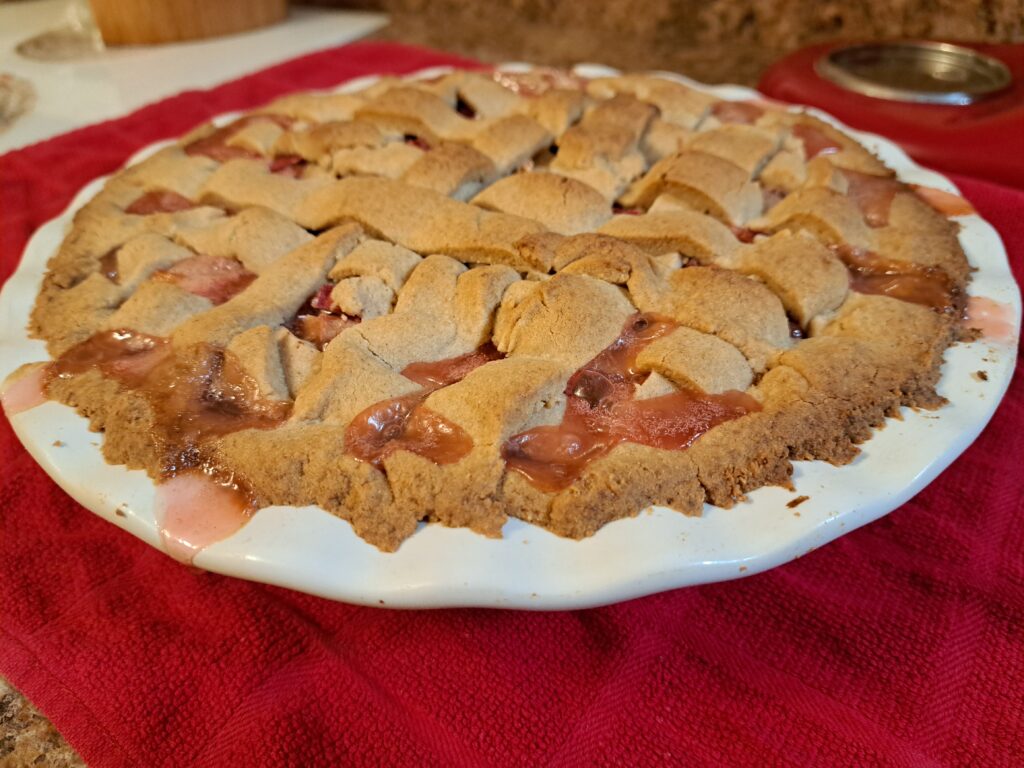
Rhubarb pie with a lattice crust
A few pies which use this pie crust recipe:
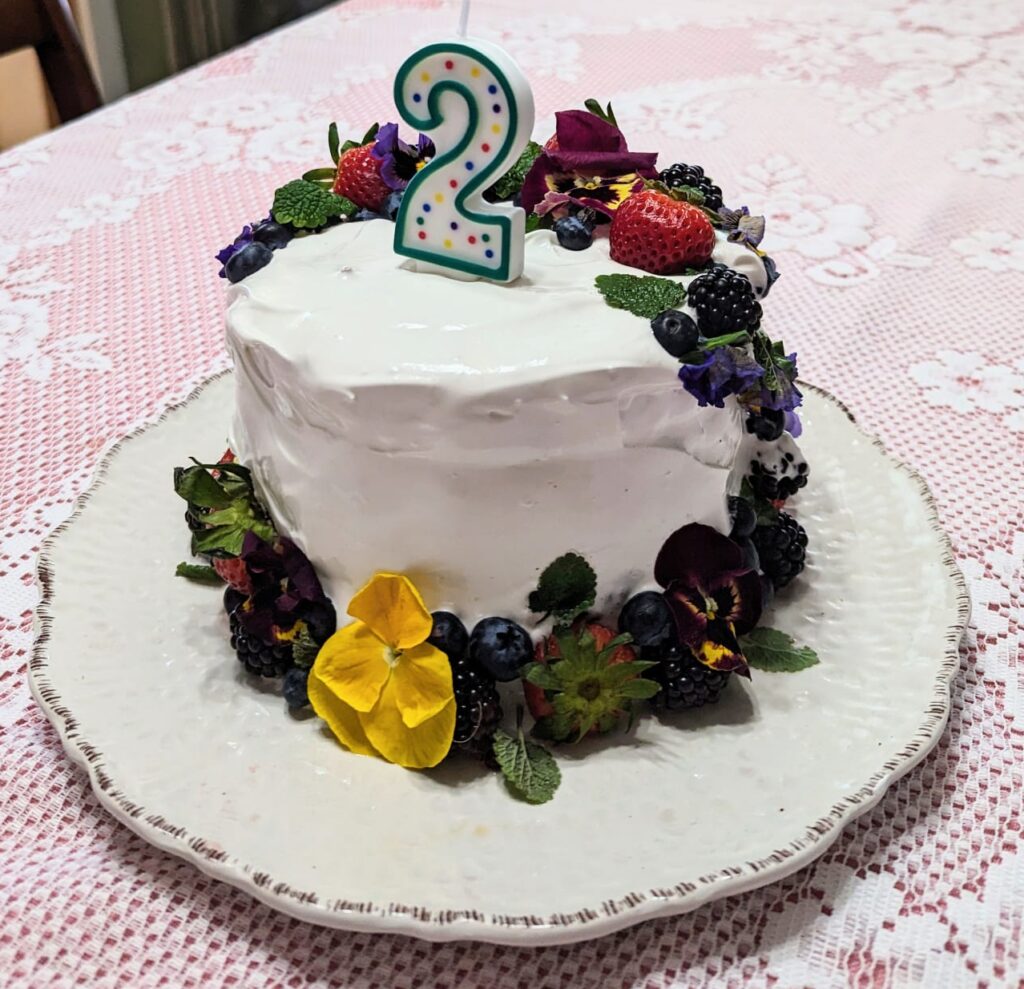
Marshmallow frosting on a chocolate cake with fruit and flowers
Imagine a soft white layer of marshmallow over a cake. Its sweet, but not too sweet. Its light, but still satisfying. It tastes absolutely delicious when paired with chocolate cake. That's what you will get with marshmallow frosting, also known as Italian meringue.
As an added bonus, this is one of those recipes where you get to bring out the candy thermometer.
My family is gluten free for health reasons. And good news: this marshmallow frosting is entirely gluten free! No substitutions, no fuss, its just sugar, water, and egg whites by design.
Its also dairy free, which is what drew me to trying Italian meringue a few years ago. Before I discovered this pillowy delight, I always used buttercream on my cakes. But then I had to be dairy free for about six months for the sake of my baby daughter (milk protein intolerance; there were a lot of colicky nights). The combination of dairy and gluten free is pretty rough. But the good news is: this marshmallow frosting is naturally dairy free and gluten free!
Marshmallow frosting holds together nicely, and sticks to a cake. But it does not do well as a filling between layers. The weight of a cake easily pushes it out from between cake layers, leaving you with only a tiny coating. That is a significant disadvantage compared to buttercream.
There are a few ways to work around this.
One is simply to resign yourself to having a smaller cake. Maybe just two layers, with a light layer of filling in between each. Marshmallow frosting works fine for this.
Another is to provide another sort of structure to keep your layers separate. I have used fruit - specifically blackberries - secured with toothpicks for this purpose in the past, and it has turned out great. Basically, you arrange your fruit in between each layer, and spear a toothpick through the fruit and cake layers in a few key places. Fill in between pieces of fruit with your frosting. Enjoy the amazing combination of fruit, cake, and marshmallow!
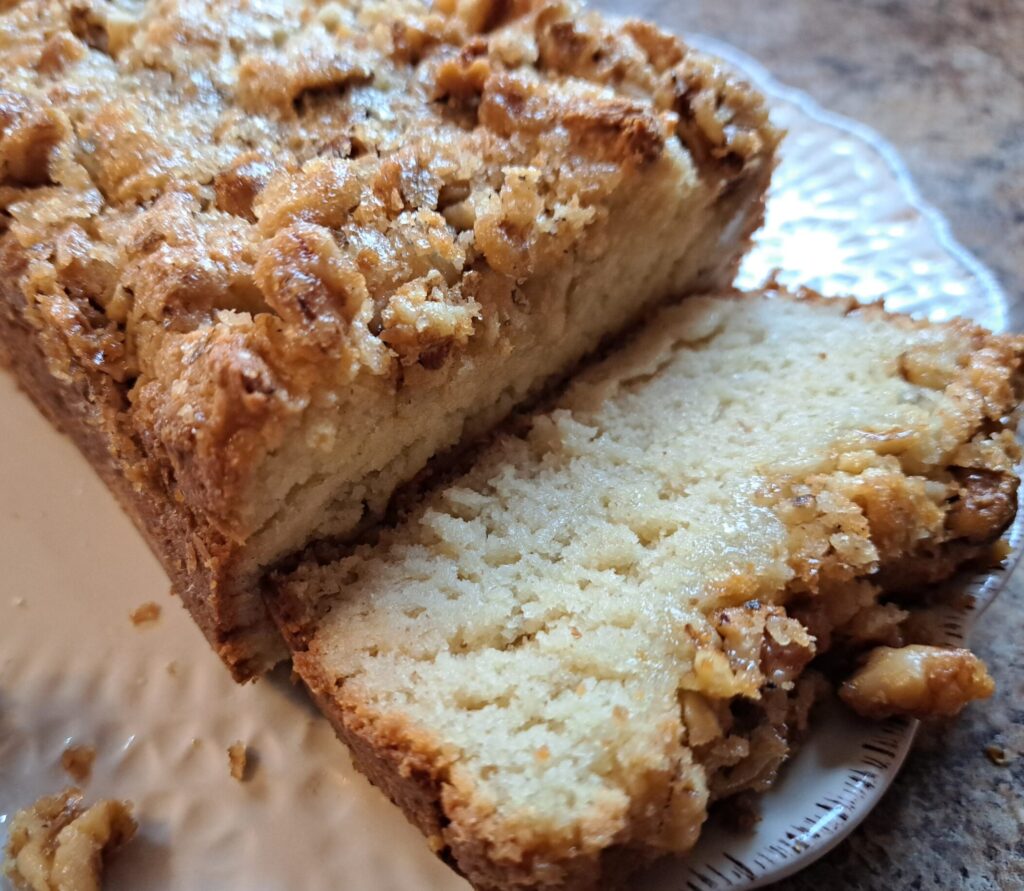
The first slice of banana bread, fresh from the oven. Yum!
A healthy and delicious take on gluten free banana bread, this recipe brings some nuttiness in with almond flour and a walnut crumble on top. The banana provides most of the sweetness, as well as the all-important banana flavor. The almond flour gives it a soft cake-like texture and nutty flavor. The crumble topping gives the bread a toothsome crunch, and that little bit of extra sugar.
Enjoy your gluten free banana bread with breakfast, or as an afternoon snack. It pairs wonderfully with spicey scrambled eggs, and a cup of tea or coffee.
Of course, it always tastes best warm, straight from the oven.
I tried a few different approaches to making gluten free banana bread before I thought to add in almond flour. Namaste Perfect Flour Blend alone makes a pretty good banana bread - it is moist, and flavorful. But it is also a little too gummy for my tastes.
(This is often an issue with Namaste Perfect Flour Blend, although it makes amazing pancakes.)
Adding the almond flour to the flour blend reduces the gumminess, and makes it more cake like. Even, dare I say, more like "wheated" banana bread. And isn't that the goal?
Between the banana and the milk, there is decent volume of wet ingredients in this batter. You want to make sure it does not get too wet. The batter should be stiff when you put it into your chosen baking pan. If it is even a little bit "soupy," you may end up with a raw-tasting bread.
Speaking of chosen baking pan, I have tested this recipe both as a "coffee cake" baked in a casserole dish or a pie plate, and as a "bread" baked in a cast iron bread pan. I do recommend the cast iron bread pan - both because of the aesthetics, and because the cast iron helps it cook all the way through faster. But either approach will work.
Once the bread is in the oven, it needs ever minute of its cook time in order to be completely done. And even when it looks done - maybe give it 5 more minutes. Also, please note: the crumble topping can "disguise" the toothpick test by coating the toothpick in butter so that it emerges clean when it really is not done in the center.
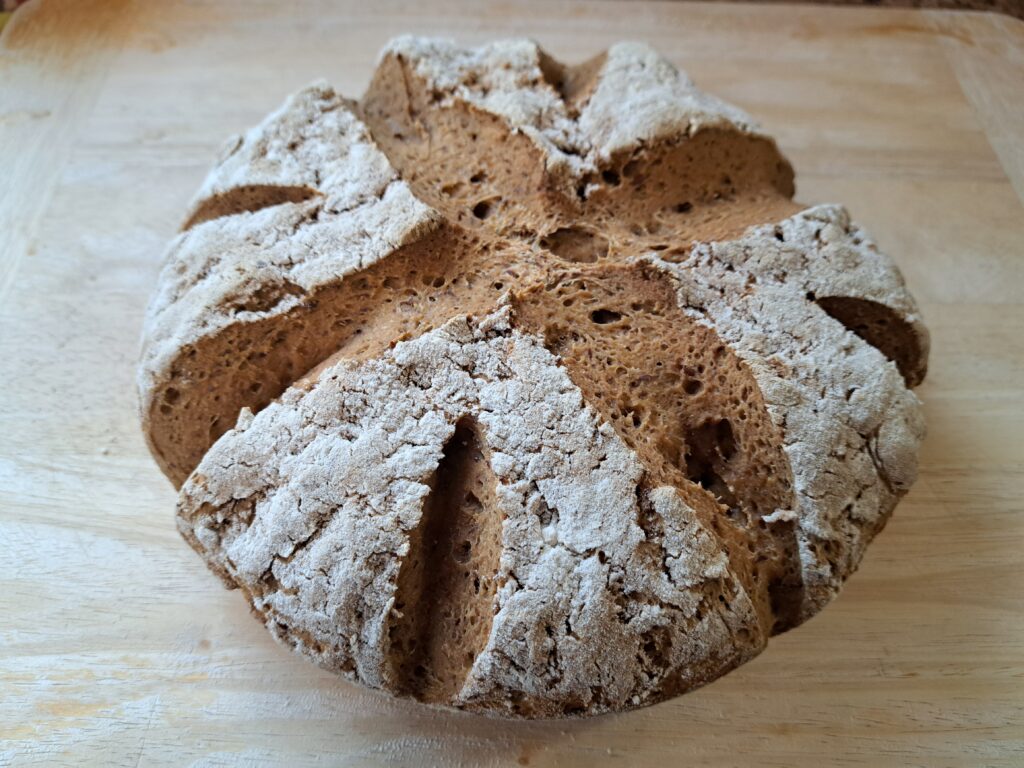
A crusty loaf of gluten free sourdough bread - the reward for keeping gluten free sourdough starter
For years, I thought that sourdough bread was out of reach on a gluten free diet. That classic recipe of just flour, water, and salt to make bread requires wheat flour, after all. Will the wild yeasts still come to give the bread rise if the bread is made of gluten free flour? Can you ferment gluten free dough when it has so many extra ingredients, like flaxseed and psyllium husk, and eggs? Surely such deliciousness as sourdough is out of reach if you cannot have wheat...
Not true. Sourdough starter can be made from many different types of flour, including gluten free ones, such as brown rice flour, sorghum, and buckwheat. Yes, you can have gluten free sourdough! You just have to make your own gluten free sourdough starter.
In order to make anything sourdough, you need sourdough starter. The starter is a flour, water, and yeast mixture, that you can then add to almost any baked good. It adds a sour tang to your breads, pancakes, or biscuits. Additionally, the yeast in the sourdough makes the nutrients in the flour more digestible, making fermented sourdough baked goods more nutritious.
Making the starter is easy - put an equal amount of flour and water in a jar on your countertop, out of direct light. Every day, discard half of the starter, and replace it with equal parts flour and water. After a few days, the starter should start bubbling. After a week, it is ready to use.
As long as you have your starter, you need to keep feeding it. That means adding equal parts flour and water every day. The more starter you have, the faster it will eat through that new flour, and so the more flour you will need to add to keep it happy. The solution to the ever increasing appetite of sourdough starter is to use it, or discard it. More on that below.
You can use any gluten free flour you like in your sourdough starter, though wholemeal ones will probably work the best. I personally use brown rice flour, and sorghum. I have also used just brown rice flour, and it worked quite well. Millet flour and buckwheat are also good options.
What happens if you don't feed your starter?
Terrible, awful things.
Forgetting to feed your starter for one day is not a big deal. The water will separate from the flour, and it will bubble sullenly at you. Just stir it, and feed it again, and the starter will be fine.
But if you leave it for multiple days, you put your sourdough starter at danger for mold growth. When the starter is healthy and well fed, the "good" yeasts in the starter are able to keep the bad bacteria at bay. When they are hungry and weak, harmful bacteria can multiply, and leave you with an inedible sludge. Sourdough starter gets stronger with age, so you may have more room for error if you have an older starter.
What mold or other nastiness you get will depend upon your environment. For me, I had two starters ruined by a pink "mold" that smelled vaguely like bad cheese. The first time, my starter was a few months old, and I had no backup in the fridge. I had to throw the whole thing out. The wisdom of the internet suggested that what I encountered was serratia marcescens, a pink-colored bacteria which loves moisture, and can cause various infections in humans. Some people say that they have salvaged starters from serratia marcescens, but given that this bacteria is one that often haunts the dark corners of bathrooms, I opted to start over. Best to be safe.
Once your starter is old enough to use - so at least a week old - then you can put it in the fridge. This will slow down its growth, meaning that you only have to feed it once a week. This keeps it from going bad just because life got in the way of feeding it for a few days.
Now I do not keep my starter in the fridge, despite my previous mishaps. The reason is that I want it to grow and mature as fast as possible to fuel my baking. An older starter makes more delicious baked goods.
But I do keep all the sourdough discard in the fridge. This lets me dip into it whenever I have extra baking to do, and as long as I use the discard in a week, it is on hand as a "backup starter" should my primary starter suffer a mishap. That extra bowl of discard saved me from starting again from scratch on my second run-in with serratia marcescens.
If you need to be gone for an extended period of time, sourdough starter will be fine in the refrigerator for a week or so. I have left it as long as two weeks in the fridge with no harm done. But after a couple of weeks, it will need to be fed.
For even longer periods of time, you can store some starter in the freezer. It will keep there safe and sound for about a year.
In both cases, you will need to give the starter some time to "wake up" once you take it out of its place of cool storage.
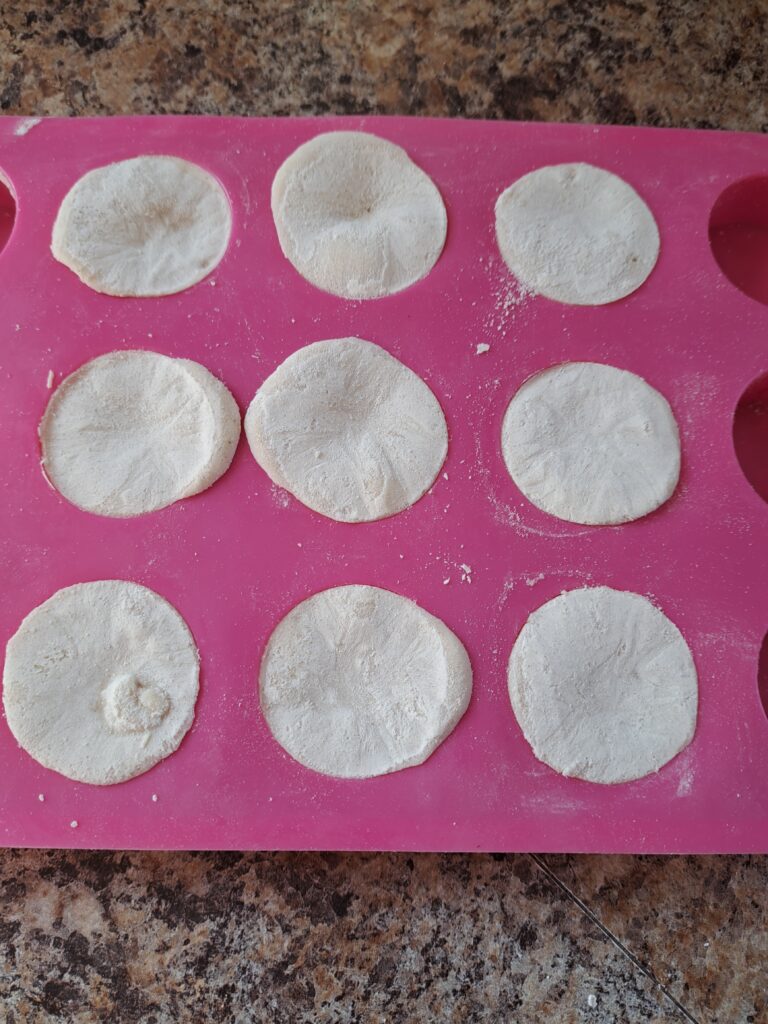
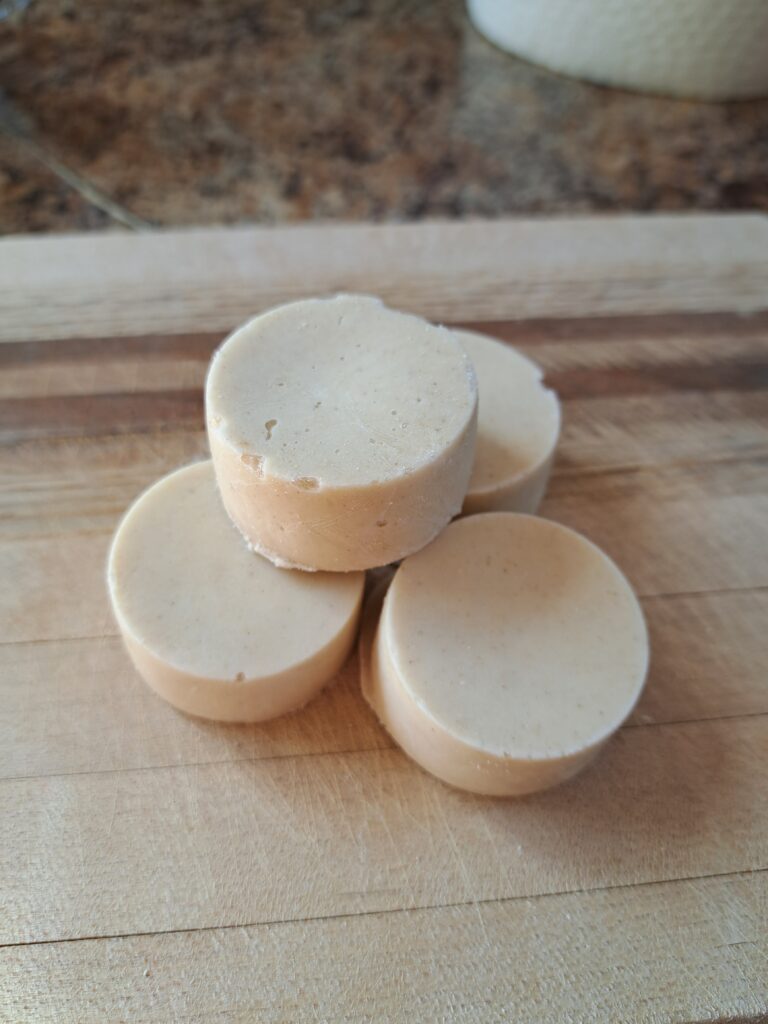
Put your sourdough starter in a silicon mold to create little sourdough disks and freeze for later!
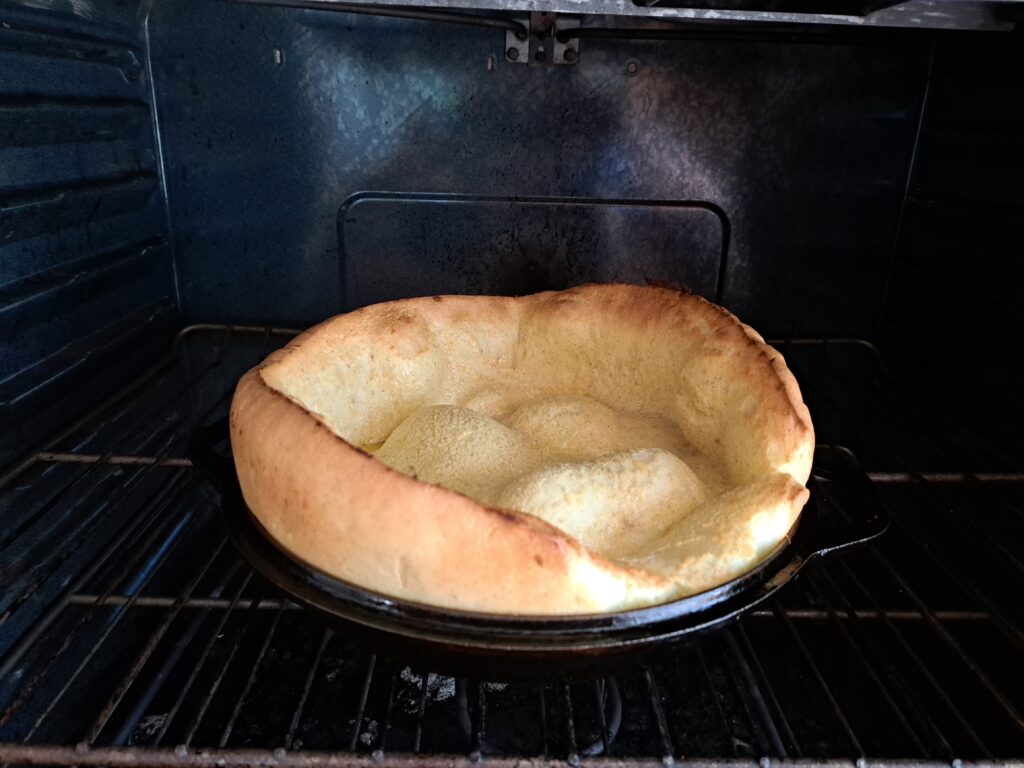 The perfect fluffy baked good - its crispy on the outside, fluffy on the inside, and the perfect receptacle for syrup, butter, fruit, or whipped cream. I'm talking about the dutch baby, or german pancake. This recipe is perfect for those days when you want to put breakfast (or your meal of choice) in the oven, and not worry about it while it cooks.
The perfect fluffy baked good - its crispy on the outside, fluffy on the inside, and the perfect receptacle for syrup, butter, fruit, or whipped cream. I'm talking about the dutch baby, or german pancake. This recipe is perfect for those days when you want to put breakfast (or your meal of choice) in the oven, and not worry about it while it cooks.
... though you might want to take a minute here and there to watch it bake. The eggs cause the pancake to puff up and double in size. The pancake "falls" again once it is removed from the oven and has a moment to cool. But that moment when you take it out of the oven? So impressive!
And for an extra special treat, enjoy your gluten free german pancake with butter syrup. Delicious!
Also called a Dutch Baby, the German pancake is neither German, nor is it Dutch. It was developed in the USA in the early 1900's, at a restaurant in Seattle Washington. Though the source has long been archived, you can still read about that restaurant and the creation of the "Dutch Baby" here.
Some people say the German Pancake was inspired by the German Pfannkuchen, and perhaps it was. But it bears a much larger resemblance to a popover, or sweet Yorkshire Pudding.
Like many gluten free recipes, the behavior of this pancake depends on the flour you use. I would say it is more finnicky than most about what will and will not create the perfect fluffy pancake. You can use any cup for cup gluten free flour, but certain mixes cause a denser and thicker pancake. I have tried it with rice flour, flaxseed, various cup for cup gluten free flour mixes including Bob's Red Mill, and also Namaste Perfect Flour blend.
Rice flour by itself does not hold together properly. It needs something to help the eggs bind.
Rice flour with flaxseed as a binding agent separates for some reason. The result is much closer to an egg dish than a pancake dish.
Most cup for cup gluten free flours with xanthum gum work as expected. But Namaste Perfect Flour Blend - which is one of my goto flour blends - gives a very dense thick pancake. This is quite nice in its own way, but it isn't really the German Pancake experience.
I recommend using Bob's Red Mill All Purpose Flour, along with a little psyllium husk. It has no xanthum gum, but still holds together wonderfully. It should give you the proper fluffy rise, and crunchy crust.

Butter syrup, with a german pancake and bacon - a great Saturday morning breakfast!
Maple syrup, honey, corn syrup... these are all wonderful sweet syrups to top your pancakes with. But have you tried butter syrup? It is sweet, buttery, and has a satisfying tang - such a great way to mix up your morning pancakes!
This syrup takes a few minutes to make, but you can easily do it while flipping pancakes, or while a german pancake bakes in the oven.
The key to butter syrup is the amount of time the butter-sugar-milk mixture gets to bubble away on the stove. About 7 minutes is perfect. Less than that, and the syrup will be a little too thin. Don't get me wrong - it will be delicious no matter what, but it will not fully come together until its had its 7 minutes of simmering.
If you let it bubble too long, I suppose it could get too thick. I have not ever been in danger of making this mistake - I'm always in a hurry to finish the syrup and get on to eating breakfast!
This recipe makes about a cup of syrup, which is more than adequate for 2-3 people. If you have more than 4 people who will be partaking, then double the recipe, just to be sure.
That ~1 cup of liquid will bubble up while it is cooking. As in, it will at least double in size when you add the baking soda. So make sure your pan is large enough to accommodate that sudden increase in volume!
The syrup does settle back down as it cools, however, so you do not need to worry about the serving pitcher. Anything that can hold 1-2 cups of liquid will be adequate.
Calls to action, and links with emphasis, buttons are a key part of a website's navigation. Below are some example styles for your inspiration, along with the CSS that makes them pretty.
All of these buttons are div elements wrapped in links. The div gives us the ability to add top and bottom padding, and make the link look more button-like.

Flatbread and falafel sandwich
If you happen to also be on a sourdough journey, then you know that there is always sourdough discard to spare. A healthy sourdough starter generates so much of that sour goodness! This recipe will use up that extra discard, imparting just a hint of sourdough flavor.
I've written this recipe with the idea that you will want to immediately cook and eat your sourdough flatbread. However, if you are not impatient like me, you can leave the dough to ferment overnight in the fridge. This will give it an extra sourness which is absolutely delightful.
This recipe makes eight flatbreads. If you have a small family, that might be too much. And unfortunately, flatbread does not keep well in the fridge once its been cooked. It tends to loose that great fresh taste and texture. So if you don't think you'll be able to eight all eight pieces in one sitting, simply cook up half today, and half tomorrow. The dough only gets better in the fridge overnight!
 These pancakes are rich, delicious, and doughy with a hint of sweetness. They are perfect for a weekend breakfast or brunch - they are certainly part of Saturday morning at our house!
These pancakes are rich, delicious, and doughy with a hint of sweetness. They are perfect for a weekend breakfast or brunch - they are certainly part of Saturday morning at our house!
And with a little bit of butter syrup? Divine.
My husband is especially fond of the texture of these pancakes. They are not exactly like wheat-ed pancakes. Yes, they are fluffy. But they are also soft and doughy in a way specific to gluten free recipes. The key is using Namaste Perfect Flour Blend. I have tried with other gluten free flour blends, and they do not quite come out the same. I think it is the combination of white rice flour, and xanthum gum, in the Namaste mix.
I will often add a half cup of Sourdough Starter or Discard to the pancake batter. Since I do not leave the batter to rise or ferment, it barely gives it any sourdough flavor, but it does make the pancakes just a little more nutritious!
If you don't have sourdough starter to use, then you can skip the sourdough. Just increase the water amount a little if the batter seems too thick.
